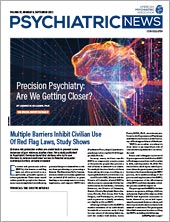Extreme risk protection orders (ERPOs), also known as red flag laws, are often pointed to as a politically palatable option to reduce gun deaths. These court-issued orders prohibit people who demonstrate concerning behaviors indicating potential danger to themselves or others from purchasing or possessing a firearm. The Bipartisan Safer Communities Act that was recently signed into law included $750 million in grant funding to encourage states to create, implement, and improve ERPO laws (“
Congress Passes First Significant Gun Safety Bill in Decades”).
In many states, civilians can file ERPOs to temporarily restrict access to firearms for people who present a risk of harm to themselves or others. Yet multiple barriers hinder civilians from taking this step, according to a report published in Psychiatric Services.
As of October 2021, 19 states and the District of Columbia allowed ERPOs, which are most commonly filed by law enforcement. In California, Colorado, Delaware, the District of Columbia, Hawaii, Illinois, Maryland, Massachusetts, Nevada, New Jersey, New York, Oregon, and Washington, civilians, such as partners or family members, are eligible to file an ERPO.
Allowing civilians to file for ERPOs enables members of an individual’s household to intervene early if they become aware of alarming behavior, said the study’s lead author, Laura Prater, M.P.H., Ph.D., an assistant professor in the Department of Psychiatry and Behavioral Sciences at the University of Washington School of Medicine.
“ERPOs are a safety net when it’s clear there is an immediate risk of someone hurting themselves or others,” she said.
Prater and colleagues interviewed 15 participants who had filed an ERPO in Washington state between December 8, 2016, and September 30, 2020. The researchers asked open-ended questions about the participants’ perceived barriers or facilitators during the ERPO process, their understanding of the process and implications of the ERPO, their perceptions of the effectiveness of the ERPO, and their thoughts on how the process could be improved.
The participants filed ERPOs for their spouses, ex-spouses, siblings, children, and parents. Eight of the subjects of the ERPOs had expressed intentions to harm themselves, seven had represented a potential threat to others, and three represented a threat to harm both themselves and others. The participants identified numerous barriers to filing the ERPO, including the following:
•
A perceived lack of help connecting with social services: Participants reported that the primary motivation for pursuing an ERPO was to protect their family members and others from harm, as well as to connect their family members with mental health services. They expressed disappointment when they learned that their family members were not connected to services.
•
Ambiguities with the administrative and legal processes: Participants expressed a lack of clarity on the function of the ERPO, the proper steps for filing one, and how the ERPO would prevent a firearm sale. Additionally, some courthouse workers incorrectly told participants they could not file for an ERPO as a civilian.
•
Feelings of distress: Participants were hindered by the distress they felt, usually related to the initial circumstances that led to the ERPO filing. They also reported that the process felt like a conflict with the family member against whom they were filing the ERPO, and they also perceived that the officials involved in the process were biased against ERPOs.
Participants were facilitated in the ERPO process by their previous legal experience and informal advocates who helped them, the authors found.
“The ERPO process is long, complex, and can be confusing,” Prater told Psychiatric News. “We spoke to participants who had to take multiple days off work for different court appearances, and a lot of these situations were very traumatic. They could have used an advocate or someone to help them through the process.” Policymakers should consider funding and creating advocate or peer programs for people seeking to file an ERPO to help them navigate the process, Prater said.
When it comes to reducing firearm violence, there is no panacea policy that will solve the problem, pointed out Marc Manseau, M.D., M.P.H., co-founder of Psychiatrists for Gun Violence Prevention and a clinical assistant professor in the Department of Psychiatry at NYU Grossman School of Medicine. “Sometimes people tend to gravitate to relatively uncontroversial policies like ERPOs, suggesting they’re going to fix everything,” he said. Yet the driver of gun violence in the United States is the sheer number of guns per capita in the country, he said.
ERPOs, however, do show promise in helping to reduce violence, including firearm suicides. A 2018 study in Psychiatric Services found that firearm suicides in Connecticut and Indiana were significantly reduced after ERPO laws were enacted. Indiana’s law was associated with a 7.5% reduction in firearm suicides in the 10 years following its enactment.
In those few states that allow civilians to file for ERPOs, public education is key, Manseau said. “People must know what their options are,” he said.
Ultimately, larger studies are needed to determine the most effective structure of ERPO laws, Prater said. “As these policies become more common and more people file, stronger studies will be possible,” she said. “But even smaller qualitative studies can provide insight into how these policies are best used, identify the gaps, and highlight potential equity problems.”
Prater’s study was supported by funds from the State of Washington. ■

